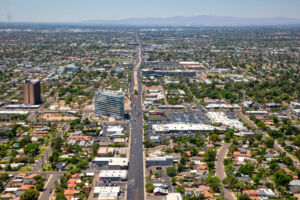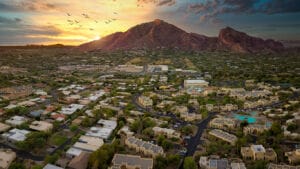Clumps of curved freeway fragments balancing on massive pillars of concrete resemble a giant modern art sculpture greeting Interstate 10 travelers through the far West Valley of the Phoenix Metro.
Later this year, those “art” segments will gel into a multi-level interchange linking the I-10 and the Loop 303, and launch the area’s burgeoning commercial development into warp speed.

The new interchange “will be a game changer,” said Kevin Czerwinski, president of Merit Partners, broker for the 1,600-acre, master-planned business park PV303, which straddles the confluence of those roadways and stretches north along the Loop 303 to Camelback Road.
For nearly a decade, the West Valley, loosely defined as everything west of Interstate 17, has been quietly emerging as the metro area’s hotbed for commercial development. It has been fueled by dwindling East Valley land availability and affordability and better transportation access. After completion of the Loop 101, developers quickly gobbled up land along the freeway for homes, shops and businesses. Then they continued the westward expansion.
Now the Loop 303 is offering another close-in frontier and shovel-ready options for new and growing businesses to expand or set down roots in the metro area. The nearly completed semi-circle of highway linking the I-10 and the I-17 will provide a high-speed route to northern states, bypassing metro area traffic congestion — a boon to companies like Dick’s Sporting Goods, which recently completed a 720,000 SF distribution center in PV303 to service its Western U.S. stores, Czerwinski said. And to other retailers such as Macy’s, TJ Maxx/Marshall’s and Target, e-commerce giants such as Amazon, and high-end manufacturers such as Sub-Zero and Cookson Doors that ferry lots of merchandise intra- and inter-state.
It’s more than just big-box industrial sites popping up in the West Valley.

Acres of farm land or empty desert hide the fact that in the offices of forward-thinking developers and savvy city economic strategists, there are detailed plans for office, light industrial and retail centers, medical complexes and regional malls to be built on that un-shoveled land.
“The West Valley’s day is coming,” said John W. Graham, president of PV303 developer Sunbelt Holdings.
Sunbelt was a big player in the East Valley boom of the 1990s and early 2000s, developing residential communities from McDowell Mountain Ranch in Scottsdale to Power Ranch in Gilbert and mixed-use complexes such as Hayden Ferry Lakeside in Tempe. Graham says the same scenario is playing out west of Phoenix now. Land Advisors CEO Greg Vogel compares Goodyear today to Gilbert of a decade ago.
First came the houses
As available and affordable East Valley land dried up, a spate of residential building in well-designed West Valley communities such as Vistancia, Estrella and Verrado have attracted home buyers at all price points, Vogel said.

A whopping 35 to 40 percent of Phoenix metro area residents now live in the West Valley, Vogel said. And all those people need places to shop, bank, and find medical care.
“Residential drives everything,” he said.
Now supermarket-anchored shopping centers and big-box power centers are springing up, two regional malls are on the drawing board, and spec office buildings are breaking ground — despite Valleywide office vacancy rates topping 22 percent. The completion of the Loop 303 interchange will accelerate that trend as it eases drive time for those who work in Phoenix but live in the far West Valley — or want to, Vogel said.
Goodyear, which is in the enviable location at the foot of the new interchange, has been proactive pitching its bounty. That includes PV303 and Goodyear AirPark, a 267-acre, shovel-ready business park at Litchfield Road and Highway 85, said Sheri Wakefield-Saenz, the city’s development services director. And Wakefield-Saenz expects Westcor’s long-planned 1.1 MSF Estrella Falls regional mall to start ringing up sales — and sales tax — in 2016.

Wakefield-Saenz predicts that even more executive offices, high-end retail and high-quality manufacturing businesses will clamor for space in Goodyear during the next decade because of the in-place infrastructure and the educated workforce already living there.
Farther north in Surprise, the story is similar. In 2008, Sands Chevrolet built the first dealership in Prasada, a 4-square-mile, mixed-use development straddling the Loop 303. Now car buyers can shop at eight different dealerships at 303 AutoShow. And more are coming, said Jeff Mihelich, Surprise’s assistant city manager in charge of the Community and Economic Development Department. Neighborhood shopping centers are in the ground or on the drawing board as well, and another regional mall is pegged to land in Prasada, although no date has been announced.

But Mihelich doesn’t want to just provide shops and services and ease the daily commute for Surprise residents. He wants to lure more quality office and industrial employers so that residents can live, work and play in their hometown. Five years ago, Surprise reorganized its economic development department and goals to focus on becoming a major employment base, “concentrating on head-of-household jobs — people who will buy homes, go to restaurants,” he said. Major strategies included streamlining approval processes, persuading developers to pre-plan projects and build infrastructure before target tenants showed up, encouraging spec building, and aggressively marketing all those attributes, Mihelich said. That positions Surprise to take advantage of pent-up business expansion plans as the recent recession wanes, he said.
“When companies are expanding, they often have contracts in hand,” he said. Having property ready to build on can mean the difference between landing or losing a major employer, he said.
Optimistm Abounds
That optimism and pre-planning is not just happening in Goodyear and Surprise. Thanks to a wealth of available and affordable land, developers are eyeing West Valley cities from Avondale and Buckeye to Peoria and Glendale as future business hubs.

The Alter Group teamed up with property owner John F. Long to take advantage of the area’s growing popularity among home builders and buyers by developing three major business parks to attract employers. Algodon Center is a 1,000-acre mixed-use campus in Avondale and west Phoenix, Aldea Centre is a 150-acre business park at 99th Avenue and Bethany Home Road, and the 229-acre Copperwing Business Park is adjacent to Glendale Airport. All three have infrastructure and zoning in place and the flexibility to accommodate Class-A, back-office and light manufacturing operations, said Justin Miller, Alter Group vice president.
“The West Valley is a big component of our future,” Miller said. “It’s an area that Corporate America can use and expand because of the abundance of land.”
He’s not concerned about high office vacancies in the metro area. The easy commute for all those road-weary West Valley residents and shovel-ready land are compelling draws for big and small employers as they ramp up their businesses, he said. Valley dwellers who haven’t ventured west of the I-17 for years might be surprised to see the explosive growth.
“If people have not been to the West Valley in a while, they should come and take a look at us,” Mihelich said. “It’s truly a robust market. People outside of Arizona are noticing.”



